All published articles of this journal are available on ScienceDirect.
Productivity of Cherry Tomato Cultivars as Influenced by Watering Capacities and Microclimate Control Designs
Abstract
Background:
Cherry tomatoes remain relatively expensive due to limited public knowledge, few producers, and lower productivity rates in Indonesia. Although cherry tomatoes are increasingly popular in modern marketplaces, they are still uncommon in traditional markets.
Cherry tomatoes have an enormous economic impact on many regions, particularly Indonesia, in the broader agricultural environment. Their cultivation, however, may be impacted by problems with water supply and climatic regulation. By evaluating how various watering capacity and microclimate control strategies affect cherry tomato productivity, this study seeks to address these challenges. The research is anticipated to offer farmers and agricultural practitioners useful information to improve cherry tomato output in response to market demands and sustainability concerns.
Objectives:
The objective of this study is to determine the effect of cultivars on the growth, yield, and quality of cherry tomatoes.
Methods:
The research is designed to determine the effect of each cultivar (Ruby, Fortesa), watering capacities (100% ETc, 75% ETc, 50% ETc), and microclimate control designs (Greenhouse, Rain shelter, Screen house) on the growth, yield, and quality of cherry tomatoes.
Results:
The cultivar Fortesa produced the highest possible fruit, biological yield per plant, maximum marketable fruit output, greater growth index, maximum fruit firmness, and water use efficiency. The cultivar Ruby performed better in terms of root-shoot ratio and fruit elasticity. The greenhouse produced the highest possible fruit and biological yield per plant, marketable fruit yield, growth index, leaf chlorophyll content, fruit firmness, elasticity and water use efficiency. In the watering capacities treatment condition, 100% ETC was more significant for parameters, such as marketable fruit yield, root-shoot ratio, growth index, leaf chlorophyll content, fruit firmness, and elasticity.
Conclusion:
Growing cherry tomato cultivar Fortesa in a greenhouse using a watering capacity of 100% ETc under the results is recommended. These conditions have improved fruit quality, making them favorable options for successful cherry tomato cultivar production.
1. INTRODUCTION
Tomatoes (Solanum Lycopersicum L.) are one of the most important basic vegetables grown worldwide. It produced 21.18 million metric tons of tomatoes in India, representing more than 12% of the world's production in 2022 [1]. Cherry tomatoes remain relatively expensive due to limited public knowledge, few producers, and lower productivity rates in Indonesia. Although cherry tomatoes are increasingly popular in modern marketplaces, they are still uncommon in traditional markets [2]. Cherry tomatoes are a sought-after horticultural product that has gained popularity among middle to upper-class communities in major cities of Indonesia. It is rich in essential bioactive principles and attributes that benefit it to become a vital member of the so-called “functional food” group [3]. Tomato production in 2022 reached 1 million tons, an increase of 4% (54.34 thousand tons) from 2021 production in Indonesia.
The climate in arid regions is characterized by long, hot summers, high solar radiation flux, dusty and dry weather, and limited water resources. Climatic effects can impact tomato yield and nutritional quality in Mediterranean greenhouses. Extreme weather events are a risk to the production. Hence, there is a need for the adaptation of innovative management strategies to mitigate the risk [4]. These stressful conditions require environmental control devices to improve the production and quality of tomato fruits [5]. Netting is frequently used to protect crops from excessive solar radiation, thus improving the thermal regime, and is applied over net-house constructions [6]. Screen houses are combined with greenhouse technologies focused on optimizing environmental conditions to maximize plant growth, development rate, and product quality [7]. Increasing crop production and productivity under protected cultivation technologies, viz., polyhouse, shade net, micro tunnel, etc., can produce resource-efficient, exportable quality vegetable crops [8]. Greenhouses, in particular, offer a combination of high crop production per unit area and efficient water usage per unit of yield [9].
Various factors, including climate, soil conditions, and tomato cultivars, influence water use efficiency (WUE). Water scarcity is increasingly becoming an economic challenge in numerous regions globally, particularly in arid and semi-arid areas [10]. The presence of warm climates, which are conducive to crop production, coupled with the impact of climate change, further exacerbates the limited availability of water resources for agricultural purposes [11]. The limitation of water resources within the context of climate change is anticipated to have a detrimental effect on plant growth and crop productivity [12]. Water reduces the oxygen level in the soil and creates environments that are very harmful to plant development [13]. Lack of oxygen adversely affects aerobic respiration, which causes a reduction in plant growth. By disturbing the uptake of nutrients, hormonal balance, and photosynthesis, growth is stopped and thus, the yield reduces. Excessive water due to heavy rainfall and poor soil drainage systems can cause plant stress due to hypoxia [14].
Cherry tomatoes require special treatment for good-quality yields. They are usually grown in greenhouses with maintained irrigation. So far, there is still not much research conducted on where to grow cherry tomatoes outside greenhouses, such as in screen houses and rain shelters, to produce optimal harvest index and quality of cherry tomatoes other than in greenhouses because not all farmers in Indonesia have greenhouses to grow cherry tomatoes. Thus, the results of this study are a novelty for research developments related to the quality of cherry tomatoes grown outside greenhouses with various levels of watering capacities. So, the objective of the present study was to determine the effect of cultivars on the growth, yield and quality of cherry tomatoes.
2. MATERIALS AND METHODS
2.1. Research Location and Time
This research was conducted at the Bale Tatanen Greenhouse, Faculty of Agriculture, Padjadjaran University, Jatinangor, Sumedang Regency, at an altitude of 685 meters above sea level and at the Field Laboratory of the Faculty of Agriculture, University of Padjadjaran in Jatinangor from December, 2022 to May, 2023. The quality parameters were analysed at the Horticulture Laboratory of the Faculty of Agriculture, Padjadjaran University, Jatinangor, Sumedang Regency.
2.2. Research Materials
The materials utilized in the research included cherry tomato cultivars of Tropical Ruby and Fortesa RZ, plastic container, planting medium (biochar, cocopeat), water, organic fertilizer, chemical fertilizer, probiotic (EM4), plastic UV 200-micron, screen net 50 mesh, ethyl acetate, DPPH granule, methanol, acetohexamide, vacuum evaporator, and refractometer. For analysing fruit firmness and elasticity, Texture Analyzer Stable Micro Systems TA.Xtplus C (Godalming, United Kingdom) was used, and for leaf chlorophyll content, a chlorophyll meter (Konica Minolta SPAD-502Plus, Tokyo, Japan) was used.
2.3. Germination/Seedling
The seeds of cherry tomato cultivars Ruby and Fortesa were prepared on germination pot trays. The germination medium was a mixture of compost and fertile soil. The pot tray was kept according to the treatments of the experiment design. Pot tray germination was stored in the germination room or greenhouse of agronomy, Agricultural Faculty, Universitas Padjadjaran. Once the seed germinates three or four foliar, it is called a seedling. The seedlings were planted in a greenhouse, rain shelter, and screen house to grow as treatments of experiment design. The cherry tomato plants were watered by three treatment watering capacities, such as 100% ETc, 75% ETc, and 50% ETc. All plants were in optimum maintenance.
2.4. Microclimate Control Designs
Planting was done in three control designs: greenhouse, rain shelter, and screen house. Greenhouse measures 24 meters long, 17 meters wide, and 6 meters high. The greenhouse roof uses 200 microns of UV plastic material, while the greenhouse walls use a screen net with a density of 50 mesh. The rain shelter consists of 200 microns of UV plastic roof with a building size of 18.5 x 5 x 3.5 meters (length x width x height). As for the screen house, only the roof is covered with a screen net with a density of 50 mesh. The screen house measures 15 x 3.5 x 2.8 meters (length x width x height).
2.5. Analyzing Tools
Once ANOVA revealed a significant effect, it was continued to the post-hoc test to find out the best treatment partially by Tukey Multiple range comparison test. Compared to LSD, LSD has a weakness, i.e., it cannot test all the treatment combinations (Gaspers. 2006). The procedure of Tukey (HSD) is as follows:
- Order treatments mean accordingly.
- The formula used is as follows:
 |
Where: p = treatment amount = t, v = error degree of freedom, r = replication amount, α = confident level, q α (p, v) = critical value obtained from the Student-t table.
- Test criteria
Compare the absolute value of two different means that distinguish the differences in HSD score.
If |µi - µj| > HSD005, it means the test result is significant.
If |µi - µj| < HSD005, it means the test result is not significant.
2.6. Sample Size
RCBD factorial experiment was comprised of 3 factors, 2 cultivars, 3 microclimate control designs, and 3 watering capacities and the treatments were replicated thrice. The sample size of this research was 54. Each treatment consisted of 4 plants for recording the data and samples for the quality analysis in the lab. A total of 108 plants were chosen for recording each parameter for quality analysis so as to determine the precision of estimates about the population parameters studied and the reliability (consistency) of conclusions about the hypotheses being tested (Table 1).
2.7. Application of Watering Capacity
Watering was made daily using a nutrient solution AB mixed with the composition solution. A total of 2 liters of each solution, A and B, was dissolved in 96 liters of water. The nutrient solution was sprinkled on the surface of the planting medium. The difference in the watering volume was made when plants were at 2 WAP.
| Solution A | Solution B |
|---|---|
| KNO3 | (NH4)2PO4 |
| Ca (NO3)2 | CuSO4 |
| Fe | MnSO4 |
| - | ZnSO4 |
| - | MgSO4 |
| - | Mo |
The amount of watering volume was based on plant evapotranspiration (ETc), which was calculated by the Soil Water Balance equation [15]:
Etc = P+I-R-D-(Wn-1-Wn).
Where Etc: evapotranspiration, P: Precipitation (mm), I: Irrigation (volume of water given) (mm), R: Runoff (Surface flow) (mm), D: Drainage (Percolation) (mm), Wn-1: Media weight on day n-1 (g), Wn: Weight of media on the nth day (g).
2.8. Measurements
2.8.1. Fruit Yield Per Plant (g)
Fruit yield per plant data was taken by harvesting the total fruits in the plant, counting the number of fruits, and weighing the single fruit weight. The number of fruits was multiplied by a single fruit weight to get the fruit yield per plant in grams (Table 2).
2.8.2. Marketable Fruit Yield (%)
The following formula was used to calculate the marketable fruit yield (%):
 |
| Information | Class | Weight(g) | Form | Classification | Damage percentage (%) |
|---|---|---|---|---|---|
| Market worthy | A | ≥4 | Symmetrical | Marketable | 0 |
| B | <4 | Not symmetrical | Unmarketable | ≤10 |
2.7.3. Root-shoot Ratio
The root-to-shoot ratio of the cherry tomato plant was calculated by the following formula:
 |
2.8.5. Leaf Chlorophyll Index (SPAD)
The leaf chlorophyll index was measured using a SPAD meter, a non-destructive method that provides an indirect measurement of the total chlorophyll index. The SPAD meter measures a combination of chlorophyll a and chlorophyll b levels without distinguishing between the two pigments. This approach provides a rapid assessment of the overall leaf chlorophyll index.
2.8.6. Fruit Firmness and Elasticity
Texture measurement (firmness and elasticity) refers to the method of using a Texture Analyzer (Stable Micro Systems, Model: TA.TXT. Plus). Measurements were made at three points, namely at the top, middle, and bottom of the fruit. The hardness value of tomatoes was calculated in units of g/force or Newton.
3. RESULTS
3.1. Mean Daily Evapotranspiration (mL)
Fig. (1) shows the experimental sites' monthly mean daily evapotranspiration (mL). An essential piece of evidence in our inquiry is this figure. The water requirements of cherry tomato plants require a grasp of evapotranspiration, the process by which water is moved from the soil to the atmosphere through plant transpiration and soil evaporation. The study thoroughly examined cherry tomato cultivars with a specific focus on how they responded to various watering levels. Increasing productivity significantly while preserving water resources by optimizing watering procedures is possible. Plant development and yield can be significantly impacted by microclimates, which are small-scale climate differences within a broader climate zone. A more hospitable environment for cherry tomato growth may result from applying efficient microclimate control measures, potentially resulting in increased yields and better fruit quality.
3.2. Fruit Yield Per Plant (g)
The analysis revealed significant (P<0.05) differences in fruit yield per plant (Fig. 2). Specifically, the cultivars and microclimate control designs were found to have a significant (P<0.05) impact on fruit yield per plant, while the watering capacity did not show a significant (P<0.05) effect. Furthermore, the interactions between microclimate control designs and watering capacity and between cultivars, microclimate control designs, and watering volume were also significant (P<0.05). When examining the cultivar's treatment, the highest fruit yield per plant was observed in the Fortesa, reaching an impressive 532, following the cultivar Ruby, with a fruit yield per plant of 290. Regarding the microclimate control designs, the greenhouse design exhibited the highest fruit yield per plant, 468, indicating favorable conditions for plant growth. The rain shelter design showed the second-highest yield at 406, while the screen house design had the lowest fruit yield per plant, recording 359.
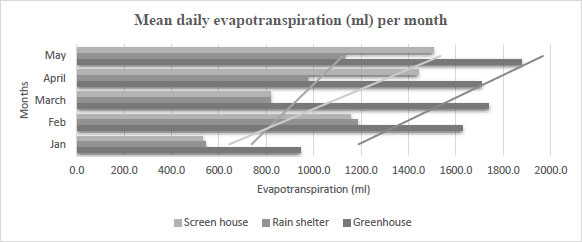
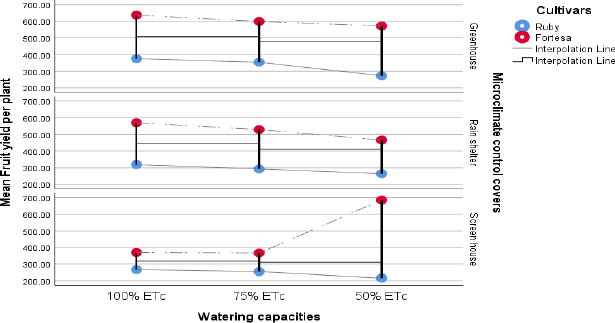
3.3. Marketable Fruit Yield (%)
The research findings indicate that three main factors, microclimate control designs, watering volume, and cultivars, significantly (P<0.05) impact the marketable fruit yield of cherry tomatoes (Fig. 3). However, when these factors interact, their combined effect on marketable fruit yield is insignificant (P<0.05). Regarding the cultivars, Fortesa exhibited the highest marketable fruit yield at 86%, outperforming Ruby, which had a lower yield of 84%. The greenhouse method proved the most effective regarding the microclimate control designs, resulting in a maximum marketable fruit yield of 87%. On the other hand, the rain shelter method produced a slightly lower but statistically similar marketable yield, while the screen house yielded 84% of marketable fruit. Considering the impact of watering capacity, cherry tomatoes watered at 100% ETc achieved the highest marketable fruit yield at 86.88%. Notably, watering at 75% ETC also yielded a high percentage of marketable fruit, reaching 85.82%. However, the marketable yield decreased when watering was reduced to 50% ETC, resulting in a lower marketable fruit yield of 84.12%.
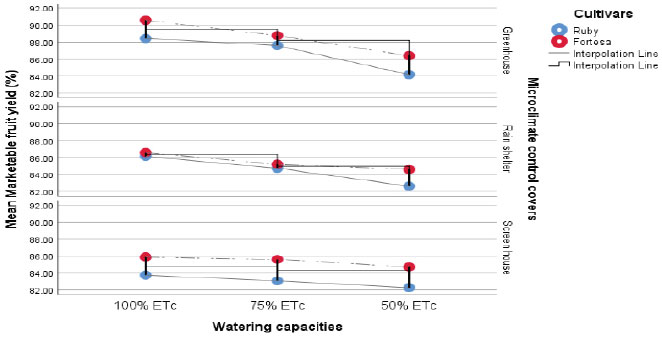
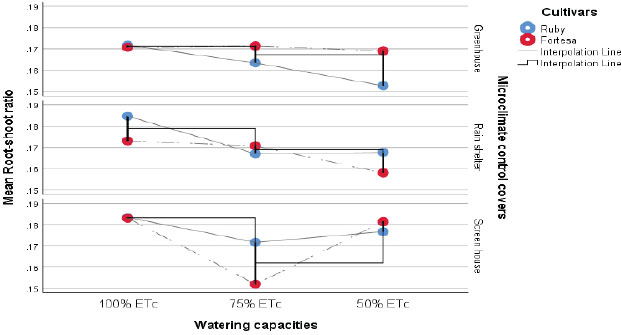
3.4. Root-shoot Ratio
The data analysis of the root-shoot ratio revealed that three factors had a significant (P<0.05) impact: cultivars, microclimate control designs, and watering volume (Fig. 4). Additionally, the interaction between cultivars and microclimate control designs and watering volume and microclimate control designs significantly (P<0.05) influenced the root-shoot ratio. Moreover, the interaction between cultivars and microclimate control designs and watering capacity and microclimate control designs was also significant (P<0.05). When comparing the cultivars, the Ruby cultivar had the highest root-shoot ratio of 0.1738, while the Fortesa cultivar had the lowest ratio of 0.1692. Among the different microclimate control designs, the screen house had the highest root-shoot ratio of 0.1788, followed by the rain shelter with 0.1696, and the greenhouse had the lowest root-shoot ratio of 0.1661. Regarding watering volume treatments, the 100% ETc treatment resulted in the highest root-shoot ratio of 0.1769, followed by the 75% ETc treatment with 0.1699. The 50% ETc treatment produced the lowest ratio of 0.1676.
3.5. Growth Index (%)
The data analysis on the growth index of cherry tomatoes revealed that the microclimate control designs and watering capacity significantly (P<0.05) impact the growth index (Fig. 5). However, the different cultivars of cherry tomatoes showed no significant (P<0.05) differences in their growth index. When examining the interactive effects, it was found that the combination of cultivars and microclimate control designs, as well as the combination of cultivars, microclimate control designs, and watering capacity, had significant effects on the growth index of cherry tomatoes. Regarding the growing structure, the greenhouse demonstrated the highest growth index at 17%, followed closely by the rain shelter at 17.10%. The screen house had a slightly lower growth index at 16.81%. Regarding watering capacity treatments, cherry tomatoes grown with 100% ETc showed the highest growth index at 18.08%. The 75% ETC treatment had a growth index of 16%, which was statistically similar to the 50% ETC treatment, which had a growth index of 16%.
3.6. Leaf Chlorophyll Content (SPAD)
The analysis of the chlorophyll content in cherry tomatoes revealed that the microclimate control designs and watering volume factors had a significant (P<0.05) impact (Fig. 6). In contrast, the factor of cultivars was found to be non-significant (P<0.05). Additionally, all interactions between cultivars and microclimate control designs, cultivars and watering volume, microclimate control designs and watering volume, and the interaction of cultivars, microclimate control designs, and watering volume were non-significant (P<0.05). Among the different microclimate control designs, the greenhouse design showed the highest chlorophyll content with a value of 40.90. It was followed by the screen house and rain shelter, both having chlorophyll content of 38.84. Regarding watering volume treatments, the 100% ETc treatment resulted in the highest chlorophyll content of 40.11, followed by the 75% ETc treatment with a range of 39.38. The lowest chlorophyll content of 39.09 was observed in the 50% ETc treatment.
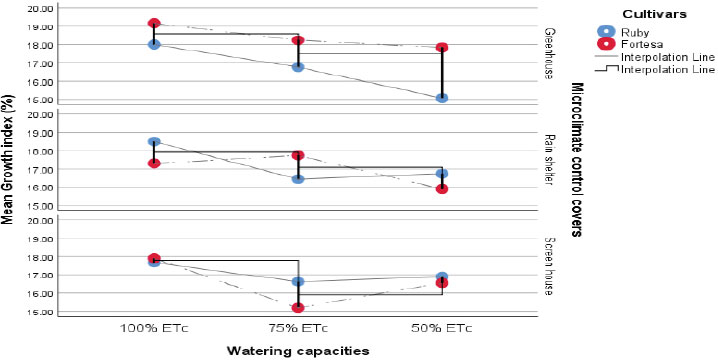
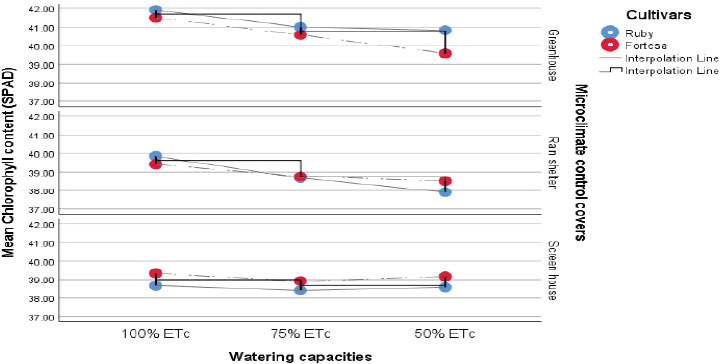
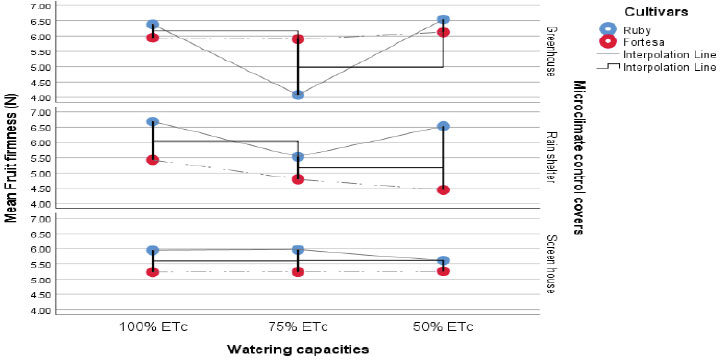
3.7. Fruit Firmness (g/cm3)
The results revealed a significant effect of cultivars on the fruit firmness of cherry tomatoes, whereas the microclimate control designs and watering volumes and all the possible interactions were found to be non-significant (P<0.05) (Fig. 7). Maximum fruit firmness of 5.91 N was recorded in cultivar Ruby, while the minimum was noticed in cultivar Fortesa at 5.37 N.
3.8. Fruit Elasticity (mm)
The data analysis indicated that the microclimate control designs, watering volumes, and cultivars significantly (P<0.05) influenced the elasticity of the cherry tomatoes (Fig. 8). Furthermore, there was a notable (P<0.05) interactive effect between the microclimate control designs, watering volumes, and cultivars. In the case of microclimate control designs, the greenhouse displayed the highest elasticity of 41.4 mm, which was followed by 30.9 mm in the rain shelter. On the other hand, the screen house resulted in a lower elasticity of 20.4 mm. Concerning watering volume, the maximum elasticity of 34 mm was recorded with 100% ETC, statistically similar to 31.5 mm with 75% ETC, while 50% ETc produced a lower elasticity of 27.2 mm in comparison to other watering. For cultivars, a maximum elasticity of 41.8 mm was recorded in the Ruby cultivar, whereas cultivar Fortesa was found to have a lower elasticity of 20 mm.
3.9. Water Use Efficiency (g/mL)
The analysis of water use efficiency data for cherry tomatoes revealed that the choice of cultivars and watering capacities significantly (P<0.05) impacted water use efficiency (Fig. 9). However, manipulating microclimate control did not
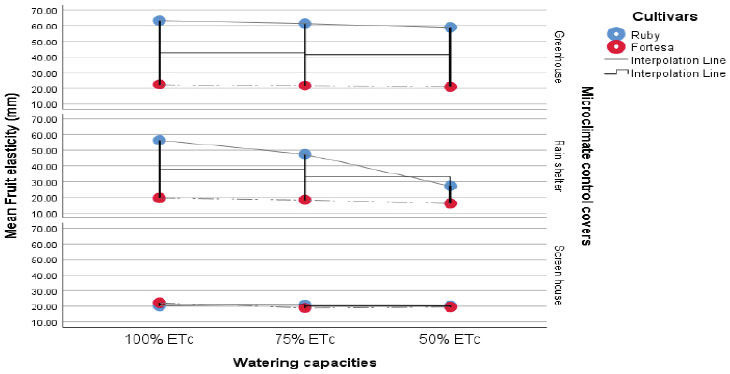

show any significant (P<0.05) effects, nor did any of the interactive effects. When considering different cultivars, the highest water use efficiency was observed in the 'Fortesa' cultivar, reaching a value of 1.60 g/mL. On the other hand, the 'Ruby' cultivar exhibited a lower water use efficiency, measuring at 1.35 g/mL. Regarding varying watering capacities, the cherry tomato plants exhibited the most significant water use efficiency when subjected to 50% ETc, with a notable value of 1.98 g/mL. The 75% ETc treatment followed closely with a 1.37 g/mL water use efficiency. However, the water use efficiency decreased notably when the plants received 100% ETc, resulting in a lower value of 1.07 g/mL.
3.10. Texture Analyzer
The information shown in Fig. (10) is essential for clarifying the mechanical qualities and textural traits of the cherry tomato cultivars being studied. We applied controlled mechanical forces to the samples to analyze the reactions in terms of force versus displacement. The resulting curve shown in Fig. (10) illustrates the force-deformation relationship and enables us to evaluate characteristics like firmness and elasticity of cherry tomato cultivars. Various curves and peaks shown in Fig. (10) provide essential details about the investigated materials' textural characteristics. Peaks on the curve indicate important aspects, such as the most significant amount of force needed to break or deform the cherry tomatoes. The analysis was carried out using the Texture Analyzer TA.Xtplus C, providing vital quantitative data that helps with product formulation optimization and quality control. It substantially contributes to our comprehension of how numerous elements affect the mechanical characteristics and texture of the tomato, offering helpful direction for product development and quality improvement.
Table 3 presents the findings of the analysis of variance (ANOVA) carried out to determine the impact of watering capacity and microclimate control designs on the measured attributes in our study. This table is an essential part of our research since it gives a statistical picture of how these two critical variables affect the traits that are being studied.
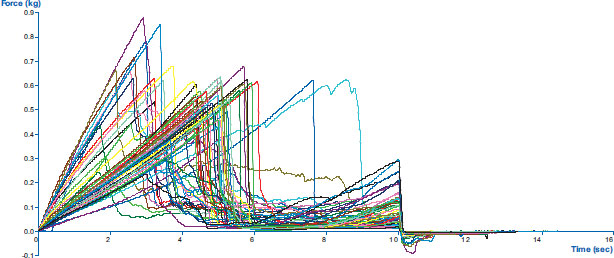
| SOV | df | Fruit Yield Per Plant | Marketable Fruit Yield (%) | Root-Shoot Ratio | Growth Index (%) | Leaf Chlorophyll Content (SPAD) | Fruit Firmness (N) | Fruit Elasticity (mm) | Water Use Efficiency (g/mL) |
|---|---|---|---|---|---|---|---|---|---|
| Reps | 2 | - | - | - | - | - | - | - | - |
| Cultivars (C) | 1 | ** | ** | ns | ns | ns | * | ** | ** |
| Watering capacity (W) | 2 | ns | ** | ** | ** | * | ns | ** | ** |
| Microclimate control designs (MC) | 2 | ** | ** | ** | ** | ** | ns | ** | ns |
| W x MC | 4 | * | ns | ** | ** | ns | ns | * | ns |
| W x C | 2 | ns | ns | ns | ns | ns | ns | ns | ns |
| MC x C | 2 | ns | ns | ** | ** | ns | * | ** | ns |
| W x MC x C | 4 | * | ns | ** | ** | ns | ns | ns | ns |
| Error | 34 | - | - | - | - | - | - | - | - |
| CV (%) | - | 22.34 | 1.94 | 3.78 | 3.64 | 2.84 | 17.20 | 20.07 | 19.69 |
4. DISCUSSION
The choice of cultivars plays a crucial role in fruit yield, as different cultivars are specifically bred for high productivity and adaptability to specific growing conditions. The combination of suitable microclimate to cultivar selection enhances fruit production, making them key factors to consider in optimizing cherry tomato production. It has been observed that yield per plant varied significantly among the tomato varieties [5]. The yield variations may also depend on genetic differences among the varieties since they were grown under the same environmental conditions [16]. Greater fruit yield under control environments is associated with producing a higher number of fruits with greater length and diameter of respective variety. The specific management helps to create ideal growing conditions, maximizing the potential of each plant and resulting in improved yield [17]. Using shade nets to shield crops from direct sunlight reduces the occurrence of fruit cracking by minimizing the daily expansion and contraction of the fruits [18]. Growing structures, such as greenhouses or open fields, offer distinct environmental conditions that impact plant growth and fruit quality [19]. Adequate watering volume is essential to ensure healthy growth, minimize water stress, and reduce fruit abnormalities [20]. Understanding how these variables interact can result in improved production processes and higher marketable fruit yields, which will help farmers and the entire supply chain [21]. The amount of water supplied directly influences root growth and shoot development. Adequate watering fosters robust root growth, allowing the plant to uptake more nutrients and water and stimulating shoot growth [22]. The optimization and uniformity of the interior climate of plant factories result in the production of dry matter that is higher and more consistent than in greenhouses [23]. The water use efficiency increases with lower ventilation requirements. Diverse growing conditions are pivotal in determining the accessibility of sunlight, airflow, and nutrient distribution to the plants [24].
Optimal microclimate control designs can create a conducive environment for cherry tomatoes to thrive, promoting better root development, stronger stems, and increased fruit production. The quantity and frequency of water input directly affect the transpiration rates, photosynthesis, and nutrient uptake, all essential for robust growth [10]. Plant health and provision of variable light and temperature conditions, which directly affect chlorophyll synthesis and accumulation, varied according to the provided growing structures. The amount of watering impacts plant water stress and nutrient availability, both of which are important for producing chlorophyll [25]. The mechanical stress that the fruit experiences during growth can be influenced by microclimate control design approaches, affecting the thickness and development of the cell walls. The considerable impact of the watering volume suggests that adequate hydration levels are essential for preserving the resilience and durability of the fruit skin [26]. A sufficient watering volume guarantees enough turgor pressure inside the cells, strengthening the cell wall [27]. The overall strength and integrity of the fruit skin can be affected by modifications in cell wall composition, including the deposition of structural elements, including cellulose, hemicellulose, and lignin. The development and makeup of the fruit's cellular structure are influenced by growing techniques and light exposure, which may impact the fruit's flexibility [28]. The plants may have experienced physiological reactions from the 50% ETc treatment due to moderate water stress. One response could be activating water-saving mechanisms, such as decreased transpiration rates, changed stomatal conductance, and enhanced root-to-shoot ratio [26]. These modifications helped enhance WUE and improve water saving. One of the most important variables affecting tomato production in greenhouses is irrigation because it serves as the sole source of water supply for crops [29]. It has been widely reported that, depending on the time and degree of water deficit, deficit irrigation decreased tomato yield but improved some fruit quality indices [30]. The amount of water utilized for irrigation can have significant impacts on WUE. The effectiveness of water application often declines as irrigation frequency increases. Water losses due to inefficient field water application might range from 28% to 50% [31].
Selecting quality indicators, such as fruit firmness, elasticity, and water use efficiency, is essential when evaluating how well cherry tomato cultivars perform when subjected to various watering regimes and microclimate control strategies. Fruit shelf life and customer choice are influenced by fruit firmness and elasticity, which are crucial fruit quality indicators. To understand how effectively water resources are used in agriculture, water usage efficiency is a vital sustainability aspect. To ensure dependability and comparability, these variables were measured using standardized techniques commonly used in agricultural research. Their inclusion in the study offers insightful information about the general productivity and viability of cherry tomato growth techniques under various circumstances.
CONCLUSION
In a study on cherry tomato cultivation, the Fortesa cultivar outperformed the Ruby cultivar in various aspects. When grown in a greenhouse with adequate watering (100% ETC), Fortesa exhibited higher fruit and biological yield per plant, greater marketable fruit yield, improved growth index, increased leaf chlorophyll content, better fruit firmness, elasticity and higher water use efficiency. These findings suggest that Fortesa, grown under these conditions, offers superior growth, yield, and quality, making it a promising choice for cherry tomato production in the studied area, meeting customer preferences and potentially offering health benefits.
The recommendations for growing cherry tomatoes, such as using the cultivar Fortesa, growing in a greenhouse, and using 100% of the ETc watering capacity, are based on our investigation's particular situation and outcomes. Recognizing that only some places or climates will respond to these suggestions is essential. Local environmental elements, such as temperature, humidity, and soil conditions, can strongly impact crop performance. Therefore, before implementing these guidelines, it is advised for producers in various places to carry out such studies while taking into account their particular characteristics. Our study offers valuable insights that may be altered to fit regional demands and climatic conditions.
ETHICAL STATEMENT
The study was approved by the Deanship of Research Committee at UNPAD (approval NIP. 197409252008121001).
CONSENT FOR PUBLICATION
Not applicable.
AVAILABILITY OF DATA AND MATERIALS
The data and supportive information are available within the article.
FUNDING
None.
CONFLICT OF INTEREST
The authors declare no conflict of interest.
ACKNOWLEDGEMENTS
The authors extend their heartfelt gratitude to all participants who contributed to this research, as well as their colleagues for their valuable insights.




